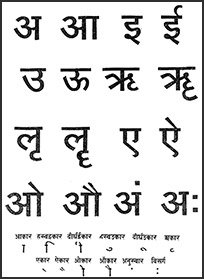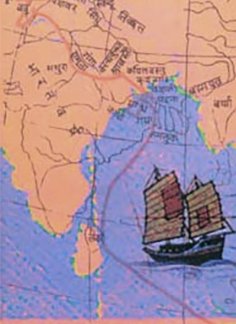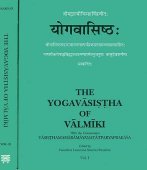Val, Vaḷ, Vāḻ, Vāḷ: 12 definitions
Introduction:
Val means something in Hinduism, Sanskrit, the history of ancient India, biology, Tamil. If you want to know the exact meaning, history, etymology or English translation of this term then check out the descriptions on this page. Add your comment or reference to a book if you want to contribute to this summary article.
The Sanskrit terms Vaḷ and Vāḷ can be transliterated into English as Val or Vali, using the IAST transliteration scheme (?).
Images (photo gallery)
In Hinduism
Vyakarana (Sanskrit grammar)
Source: Wikisource: A dictionary of Sanskrit grammarVal (वल्).—Short term (प्रत्याहार (pratyāhāra)) for consonants excepting य् (y); cf. लोपो व्योर्वलि (lopo vyorvali) P. VI. 1.66; आर्धधातुकस्येड् वलादेः (ārdhadhātukasyeḍ valādeḥ) P. VII.2.35.

Vyakarana (व्याकरण, vyākaraṇa) refers to Sanskrit grammar and represents one of the six additional sciences (vedanga) to be studied along with the Vedas. Vyakarana concerns itself with the rules of Sanskrit grammar and linguistic analysis in order to establish the correct context of words and sentences.
India history and geography
Source: Cologne Digital Sanskrit Dictionaries: Indian Epigraphical GlossaryVal.—sometimes regarded as (1/20) of a gadyāṇa. Note: val is defined in the “Indian epigraphical glossary” as it can be found on ancient inscriptions commonly written in Sanskrit, Prakrit or Dravidian languages.

The history of India traces the identification of countries, villages, towns and other regions of India, as well as mythology, zoology, royal dynasties, rulers, tribes, local festivities and traditions and regional languages. Ancient India enjoyed religious freedom and encourages the path of Dharma, a concept common to Buddhism, Hinduism, and Jainism.
Biology (plants and animals)
Source: Google Books: CRC World Dictionary (Regional names)1) Val in India is the name of a plant defined with Adenanthera pavonina in various botanical sources. This page contains potential references in Ayurveda, modern medicine, and other folk traditions or local practices It has the synonym Adenanthera polita Miq. (among others).
2) Val is also identified with Celastrus paniculatus It has the synonym Diosma serrata Blanco (etc.).
3) Val is also identified with Cocculus hirsutus It has the synonym Menispermum hirsutum L. (etc.).
4) Val is also identified with Lablab purpureus It has the synonym Vigna aristata Piper (etc.).
Example references for further research on medicinal uses or toxicity (see latin names for full list):
· Formosan trees indigenous to the Island (revised) (1936)
· Flora Cochinchinensis (1790)
· Cytologia (1991)
· amaltheum botanicum (1705)
· Contrib. Bot. (1867)
· Icones plantarum formosanarum nec non et contributiones ad floram formosanam. (1915)
If you are looking for specific details regarding Val, for example chemical composition, extract dosage, diet and recipes, pregnancy safety, side effects, health benefits, have a look at these references.

This sections includes definitions from the five kingdoms of living things: Animals, Plants, Fungi, Protists and Monera. It will include both the official binomial nomenclature (scientific names usually in Latin) as well as regional spellings and variants.
Languages of India and abroad
Sanskrit dictionary
Source: DDSA: The practical Sanskrit-English dictionaryVal (वल्).—1 Ā. (valate; but sometimes valati also; valita)
1) To go, approach, hasten; अन्योन्यं शरवृष्टिरेव वलते (anyonyaṃ śaravṛṣṭireva valate) Mv.6. 41; प्रणयिनः परिरब्धुमथाङ्गना ववलिरे वलिरेचितमध्यमाः (praṇayinaḥ parirabdhumathāṅganā vavalire valirecitamadhyamāḥ) Śiśupālavadha 6.38; 6.11;19.42; त्वदभिसरणरभसेन वलन्ती पतति पदानि कियन्ति चलन्ती (tvadabhisaraṇarabhasena valantī patati padāni kiyanti calantī) Gītagovinda 6.
2) To move, turn, move or turn round; वलितकन्धर (valitakandhara) Mālatīmādhava (Bombay) 1.29; Mv.6.41; दृष्टिरन्यतो न वलति (dṛṣṭiranyato na valati) K.
3) To turn to, be drawn or attracted towards, be attached to; हृदय- मदये तस्मिन्नेवं पुनर्वलते बलात् (hṛdaya- madaye tasminnevaṃ punarvalate balāt) Gītagovinda 7; Nalod.3.5.
4) To increase; वलन्नूपुरनिस्वना (valannūpuranisvanā) S. D.116; अमन्दं कन्दर्पज्वरजनितचिन्ताकुलतया वलद्बाधां राधां सरसमिदमूचे सहचरी (amandaṃ kandarpajvarajanitacintākulatayā valadbādhāṃ rādhāṃ sarasamidamūce sahacarī) Gītagovinda 1.
5) To cover, enclose.
6) To be covered, enclosed or surrounded.
7) To return. -With वि (vi) to move to and fro, roll about; स्विद्यति कूणति वेल्लति विवलति निमिषति विलोकयति तिर्यक् (svidyati kūṇati vellati vivalati nimiṣati vilokayati tiryak) K. P. 1.
-sam 1 to mix, blend.
2) to connect, unite with (mostly in p. p.; see saṃvalita)
Source: Cologne Digital Sanskrit Dictionaries: Shabda-Sagara Sanskrit-English DictionaryVal (वल्).—r. 1st cl. (valate) 1. To cover. 2. To move. 3. To surround or enclose. 4. To go, to hasten. 5. To be attached to. 6. To grow, to increase. With vi, To move to and fro. r. 10th cl. (vālayati-te) To cherish or maintain.
Source: Cologne Digital Sanskrit Dictionaries: Benfey Sanskrit-English DictionaryVal (वल्).— (cf. vṛ), i. 1, [Ātmanepada.] 1. To cover. 2. To be attached to, [Nala] 3, 5. 3. To hasten, [Śiśupālavadha] 6, 38; [Gītagovinda. ed. Lassen.] 6, 3. 4. To move to and fro, [Śiśupālavadha] 6, 11; [Vikramorvaśī, (ed. Bollensen.)] 59, 20. 5. To increase, [Gītagovinda. ed. Lassen.] 1, 26. Ptcple. of the pf. pass. valita. 1. Surroundea. 2. Moved, [Rājataraṅgiṇī] 5, 360; 481; moving, [Mālatīmādhava, (ed. Calc.)] 16, 9; turned, 16, 19; [Amaruśataka, (ed. Calcutt.)] 83. 3. Constrained. [Causal.] To cause to move, [Śiśupālavadha] 6, 3. Cf. s. v.
— With the prep. ati ati, an-ativalita, see s. v. valita.
— With vi vi, vivalita, Turned away, [Amaruśataka, (ed. Calcutt.)] 44.
— With sam sam, saṃvalita, 1. Encompassed, [Kirātārjunīya] 5, 48. 2. United, [Mālatīmādhava, (ed. Calc.)] 73, 4. 3. Mixed [Kirātārjunīya] 5, 38. 4. Possessed of.
Source: Cologne Digital Sanskrit Dictionaries: Cappeller Sanskrit-English DictionaryVal (वल्).—valati valate [participle] valita (q.v.) turn ([intransitive]), return; break forth, appear. [Causative] valayati or vālayati cause to turn or roll.
Source: Cologne Digital Sanskrit Dictionaries: Monier-Williams Sanskrit-English DictionaryVal (वल्):—(cf. √bal, vall, and vṛ) [class] 1. [Ātmanepada] ([Dhātupāṭha xiv, 20]) valate (oftener [Parasmaipada] valati; cf. [Vāmana’s Kāvyālaṃkāravṛtti v, 2, 3]; [perfect tense] vavale; [indeclinable participle] valitvā, [Kāvya literature]; [Aorist] avaliṣṭa; [future] valitā etc. [grammar]),
—to turn, turn round, turn to (with abhimukham and [accusative], or [locative case]), [Kāvya literature; Kathāsaritsāgara] etc.;
—to be drawn or attached towards, be attached to ([locative case]), [Nalôd.; Gīta-govinda];
—to move to and fro, [Hemādri’s Caturvarga-cintāmaṇi];
—to go, approach, hasten, [Mahāvīra-caritra; Śiśupāla-vadha];
—to return id est. come back or home, [Uttamacaritra-kathānaka, prose version];
—to return id est. depart or go away again, [ib.; Hemacandra’s Pariśiṣṭaparvan];
—to break forth, appear, [Gīta-govinda];
—to increase, [Sāhitya-darpaṇa];
—to cover or enclose or to be covered (cf. √1. vṛ), [cf. Lexicographers, esp. such as amarasiṃha, halāyudha, hemacandra, etc.] :—[Causal] valayati or vālayati ([Dhātupāṭha xix, 58]; [Aorist] avīvalat),
—to cause to move or turn or roll, [Śiśupāla-vadha; Hemacandra’s Pariśiṣṭaparvan; Naiṣadha-carita [Scholiast or Commentator]];
—to cherish etc., [Horace H. Wilson] (rather bālayati; See √2. bal) :—[Desiderative] of [Causal] in vivālayiṣu q.v.
Source: DDSA: Paia-sadda-mahannavo; a comprehensive Prakrit Hindi dictionary (S)Val (वल्) in the Sanskrit language is related to the Prakrit words: Vaṃpha, Vala.
[Sanskrit to German]
Sanskrit, also spelled संस्कृतम् (saṃskṛtam), is an ancient language of India commonly seen as the grandmother of the Indo-European language family (even English!). Closely allied with Prakrit and Pali, Sanskrit is more exhaustive in both grammar and terms and has the most extensive collection of literature in the world, greatly surpassing its sister-languages Greek and Latin.
Kannada-English dictionary
Source: Alar: Kannada-English corpusVāl (ವಾಲ್):—[noun] = ವಾಲು [valu]3.
Kannada is a Dravidian language (as opposed to the Indo-European language family) mainly spoken in the southwestern region of India.
Tamil dictionary
Source: DDSA: University of Madras: Tamil LexiconVal (வல்) noun cf. vala.
1. Strength, power; வலிமை. (சூடாமணிநிகண்டு) [valimai. (sudamaninigandu)]
2. Ability; திறமை. [thiramai.]
3. Hillock; mound; மேடு. (உரிச்சொல்நிகண்டு) [medu. (uricholnigandu)]
4. Dice; சூதசங்கிதைாடுகருவி. [suthadugaruvi.] (தொல். எழுத். [thol. ezhuth.] 373.)
5. Bodice; முலைக்கச்சு. (யாழ்ப்பாணத்து மானிப்பாயகராதி) [mulaikkachu. (yazhppanathu manippayagarathi)]
--- OR ---
Val (வல்) noun < val. Quickness, speed; விரைவு. (சூடாமணிநிகண்டு) [viraivu. (sudamaninigandu)]
--- OR ---
Vaḷ (வள்) noun < வண்-மை. [van-mai.]
1. Fertility; abundance; வளம். வள்ளலார்சாத்திரம்ிதழ் மாலை [valam. vallithazh vaithiya malaiyagarathi] (சீவகசிந்தாமணி [sivagasindamani] 2732).
2. Greatness, largeness; பெருமை. வள்ளலார்சாத்திரம்ுகிர் [perumai. vallugir] (பத்துப்பாட்டு [pathuppattu] 136).
3. Narrowness; நெருக்கம். [nerukkam.] (W.)
--- OR ---
Vaḷ (வள்) noun cf. val.
1. Sharpness, pointedness; கூர்மை. வள்வாயமதி [kurmai. valvayamathi] (தேவாரம் [thevaram] 209, 1). (பிங்கலகண்டு [pingalagandu])
2. Sword; வாள். (பிங்கலகண்டு) [val. (pingalagandu)]
3. Thong, lash; வார். (சூடாமணிநிகண்டு) [variant (sudamaninigandu)]
4. Sheath; வாளுறை. (அகராதி நிகண்டு) [valurai. (agarathi nigandu)]
5. Bridle; கடிவாளம். புரவி . . . வாங்குவள் பரிய [kadivalam. puravi . . . vanguval pariya] (அகநா. [agana.] 4).
6. Ear; காது. (பிங்கலகண்டு) [kathu. (pingalagandu)]
7. Bed; படுக்கை. வள்ளலார்சாத்திரம்ே துணியே யிவற்றொடு [padukkai. valle thuniye yivarrodu] (ஏலாதி [elathi], 50).
--- OR ---
Vaḷ (வள்) noun < bala.
1. Strength; வலிமை. (பிங்கலகண்டு) வள்வார் முரசு [valimai. (pingalagandu) valvar murasu] (புறப்பொருள்வெண்பாமாலை [purapporulvenpamalai] 3, 2, கொளு [kolu]).
2. Cramp-iron, iron-band; வலிப்பற்றிரும்பு. (பிங்கலகண்டு) [valipparrirumbu. (pingalagandu)]
--- OR ---
Vāl (வால்) noun < bāla.
1. Youth, tenderness; இளமை. தாலப் புல்லின் வால்வெண் டோட்டு [ilamai. thalap pullin valven dottu] (சிலப்பதிகாரம் அரும்பதவுரை [silappathigaram arumbathavurai] 16, 35).
2. Purity; துய்மை. (பிங்கலகண்டு) ஊர்தி வால்வெள் ளேறே [thuymai. (pingalagandu) urthi valvel lere] (புறநானூறு [purananuru] 1).
3. Whiteness; வெண்மை. பணிமொழி வாலெயிறு [venmai. panimozhi valeyiru] (திருக்குறள் [thirukkural], 1121).
4. Goodness; நன்மை. வாலிதை யெடுத்த வளிதரு வங்கம் [nanmai. valithai yedutha valitharu vangam] (பத்துப்பாட்டு: மதுரைக்காஞ்சி [pathuppattu: mathuraikkanchi] 536).
5. Greatness; பெருமை. (பிங்கலகண்டு) அரக்கர்தம் வாலிய புரமூன்று மெரித்தான் [perumai. (pingalagandu) arakkartham valiya puramunru merithan] (தேவாரம் [thevaram] 1049, 9).
6. Abundance; மிகுதி. (சூடாமணிநிகண்டு) வாலிதின் விளைந்தன வைவனம் வெண்ணெல் [miguthi. (sudamaninigandu) valithin vilainthana vaivanam vennel] (பத்துப்பாட்டு: மலை [pathuppattu: malai] 115).
--- OR ---
Vāl (வால்) noun < vāla.
1. Tail; விலங்குகளின் பின்புறம் நீண்டு தொங்கும் உறுப்பு. எறிந்தவேன் மெய்யதா வால்குழைக்கு நாய் [vilangugalin pinpuram nindu thongum uruppu. erinthaven meyyatha valkuzhaikku nay] (நாலடியார் [naladiyar], 213).
2. Anything long or elongated; நீளமானது. [nilamanathu.]
3. Mischievous person; சேட்டைசெய்பவ-ன்-ள். [settaiseypava-n-l.]
4. Mischief; சேட்டை. [settai.] Local usage
--- OR ---
Vāl (வால்) noun See வாலுழுவை. வட்டவா லுடனே கூட்டி [valuzhuvai. vattava ludane kutti] (பாலவாகடத்திரட்டு [palavagadathirattu] 774).
--- OR ---
Vāḻ (வாழ்) [vāḻtal] 4 intransitive verb [Telugu: Kanarese, Malayalam: Travancore usage vāḷu.]
1. To be, exist; இருத்தல். [iruthal.] (W.)
2. To live; சீவித்தல். வாழ்த லுயிர்க்கன்ன ளாயிழை [sivithal. vazhtha luyirkkanna layizhai] (திருக்குறள் [thirukkural], 1124).
3. To flourish, prosper; செழித்திருத்தல். வாழ்க வந்தணர் வானவ ரானினம் [sezhithiruthal. vazhka vanthanar vanava raninam] (தேவாரம் [thevaram] 1177, 1).
4. To be happy; மகிழ்தல். செம்பொற் குன்றினைக்கண்டு வாழ்ந்து [magizhthal. sembor kunrinaikkandu vazhnthu] (திருவாலவாயுடையார் திருவிளையாடற் [thiruvalavayudaiyar thiruvilaiyadar] 61, 18).
5. To live the life of a married woman; சுமங்கலியாக இருத்தல். [sumangaliyaga iruthal.] Colloq.
6. To shape one’s life according to a definite set of rules; விதிப்படி ஒழுகுதல். தந்திரத்து வாழ்து மென்பார் [vithippadi ozhuguthal. thanthirathu vazhthu menpar] (ஆசாரக்கோவை [asarakkovai] 35).
--- OR ---
Vāḻ (வாழ்) noun < வாழ்-. [vazh-.] [Telugu: K. vāḷi.] Regularity, order; முறைமை. (பிங்கலகண்டு) [muraimai. (pingalagandu)]
--- OR ---
Vāḷ (வாள்) noun [Telugu: vālu.]
1. Lustre, light, splendour; ஒளி. [oli.] (தொல். சொல். [thol. sol.] 367.) வாண்முகம் [vanmugam] (புறநானூறு [purananuru] 6).
2. Brightness; விளக்கம். மாலை வாள் கொளா [vilakkam. vaithiya malaiyagarathi val kola] (கலித்தொகை [kalithogai] 119).
3. Fame; வார்த்தைக்கீர்த்தி. வலைய வாளராமீது [varthaikkirthi. valaiya valaramithu] (தக்கயாகப்பரணி [thakkayagapparani] 111, உரை [urai]).
4. Sharpness, fineness; கூர்மை. (அரு. நி.) [kurmai. (aru. ni.)]
5. Killing; கொல்லுகை. [kollugai.] (தொல். எழுத். [thol. ezhuth.] 401, உரை. [urai.])
6. Cruelty; கொடுமை. வாளரக்கி. [kodumai. valarakki.]
7. Sword, scimitar; கத்தி. [kathi.]
8. Saw; ஈர்வாள். நாளென வொன்றுபோற் காட்டி யுயிரீரும் வாள துணர்வார்ப் பெறின் [irval. nalena vonrupor katti yuyirirum vala thunarvarp perin] (திருக்குறள் [thirukkural], 334).
9. Plough; கலப்பை. [kalappai.] (நாமதீபநிகண்டு [namathipanigandu] 470.)
10. Ploughshare; உழுபடையின் கொழு. [uzhupadaiyin kozhu.]
11. Scissors; கத்திரிகை. வாளிடைப்படுத்த வயங்கீ ரோதி [kathirigai. validaippadutha vayangi rothi] (கலித்தொகை [kalithogai] 36).
--- OR ---
Vāḷ (வாள்) noun < வார்³. [var³.] String;கயிறு. (அகராதி நிகண்டு [kayiru. (agarathi nigandu]
--- OR ---
Vāḷ (வாள்) noun < வார்⁴. [var⁴.] Water; நீர். (அகராதி நிகண்டு) [nir. (agarathi nigandu)]
--- OR ---
Vaḷ (வள்) [vāḷ] noun < வார்⁶. [var⁶.] Bodice; கச்சு. (அகராதி நிகண்டு) [ kachu. (agarathi nigandu)]
Tamil is an ancient language of India from the Dravidian family spoken by roughly 250 million people mainly in southern India and Sri Lanka.
See also (Relevant definitions)
Starts with (+1463): Balakridanaka, Val-ariuri, Val-attikuruvi, Val-bi, Val-illapuccam, Val-ittukurri, Val-kai-kontal, Val-valenal, Val-varikotunkay, Val-vayacaranan, Vala, Vala-kal-vattuatanam, Vala-manjadi, Vala-ottunal, Vala-valaenal, Vala-vayvanku, Vala-yashti, Valaa, Valaa, Valaa.
Ends with (+487): Abhijval, Abhiprajval, Abhivijval, Abhyavajval, Abhyugjval, Adabau-neri-ji-val, Adval, Ahaval, Akaval, Akkiyarival, Alakkarival, Alaval, Alintaval, Aluval, Amaval, Anaval, Anneval, Antaval, Ara-purankaval, Arankaval.
Full-text (+395): Vala, Valkaranti, Valperi, Val-kai-kontal, Cavaival, Vilval, Irval, Val-varikotunkay, Vettuval, Val-illapuccam, Vetival, Vival, Valarivan, Valamalai, Curuttuval, Vallati, Samvalana, Valappan, Vellaival, Vaal river yellowwood.
Relevant text
Search found 15 books and stories containing Val, Vāl, Vaḷ, Vāḻ, Vāḷ, Vaal, Vazh, Vaazh; (plurals include: Vals, Vāls, Vaḷs, Vāḻs, Vāḷs, Vaals, Vazhs, Vaazhs). You can also click to the full overview containing English textual excerpts. Below are direct links for the most relevant articles:
Tiruvaymoli (Thiruvaimozhi): English translation (by S. Satyamurthi Ayyangar)
Pasuram 3.1.6 < [Section 1 - First Tiruvaymoli (Mutic coti)]
Pasuram 6.5.8 < [Section 5 - Fifth Tiruvaymoli (Tuval il ma mani matam)]
Pasuram 2.3.5 < [Section 3 - Third Tiruvaymoli (Unil val uyire)]
The Religion and Philosophy of Tevaram (Thevaram) (by M. A. Dorai Rangaswamy)
Nayanar 1: Sundarar (Nampi Arurar) < [Volume 4.1.1 - A comparative study of the Shaivite saints the Thiruthondathogai]
Nayanar 13: Arivattaya < [Volume 4.1.1 - A comparative study of the Shaivite saints the Thiruthondathogai]
Chapter 4.6 - (i) Symbology of the serpent and worship < [Volume 2 - Nampi Arurar and Mythology]
Feminine Sensibility in Indo-Anglian Fiction < [January 1967]
Feminine Sensibility in Indo-Anglian Fiction < [January 1967]
“Raso Val Sah” < [April - June 1974]
Heimskringla (by Snorri Sturlson)
Part 17 - King Harald's Marriage < [Chapter IX - Saga Of Harald Hardrade]
The Agni Purana (by N. Gangadharan)
Early Chola Temples (by S. R. Balasubrahmanyam)
Inscriptional References < [Chapter VII - Uttama Chola, Madhurantaka]
Bronze, group 3: Age of Parantaka I (a.d. 907 - 950) < [Chapter XI - Sculpture]
Related products




